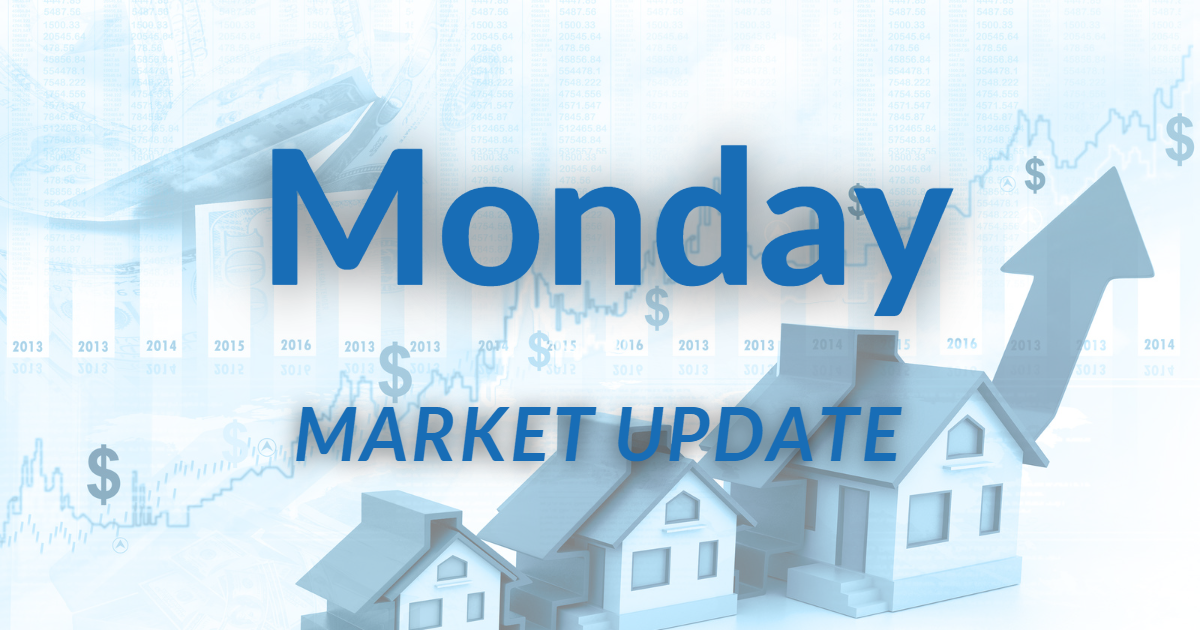
Monday Market Update
Week of January 23, 2023
Recent housing data brought some better than expected news, while wholesale inflation cooled in December. The contraction in manufacturing continued this month. Here are the details:
- Sales of Existing Homes Higher Than Expectations
- Two Sides to Housing Starts Data
- Is the Uptick in Builder Confidence a Turning Point for Housing?
- Wholesale Inflation Much Cooler Than Estimates
- Jobless Claims Continue to Reflect Slower Pace of Hiring
- Manufacturing and Retail Sales Data Point to Economic Slowdown
Sales of Existing Homes Higher Than Expectations
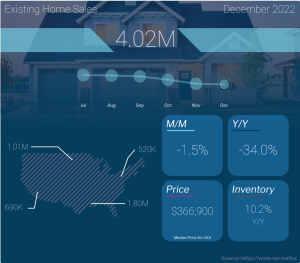
Existing Home Sales fell 1.5% from November to December to a 4.02 million unit annualized pace, per the National Association of Realtors (NAR). However, this was a smaller decline than economists had forecasted. Sales were also 34% lower when compared to December of last year. This is a critical report for taking the pulse of the housing market, as it measures closings on existing homes, which represent around 90% of the market.
What's the bottom line? Inventory continued to move lower after peaking over the summer as part of the normal seasonal build, falling for the fifth straight month to 970,000. This is a 13.4% decline from November and the equivalent of a 2.9 months' supply.
But inventory is even tighter than that figure implies, as there were only 690,000 "active listings" in December, meaning that 29% of the "inventory" in the Existing Home Sales report is under contract and not truly available. This data speaks to ongoing demand for homes, even with the decline in sales, as a normal market has 25% of inventory under contract.
Demand can also be seen in the pace of sales, as homes are still selling quickly when priced correctly. Average days on the market increased slightly from 24 days in November to 26 days in December, while 57% of homes sold last month were on the market for less than a month.
Looking at the data as a whole, low inventory and ongoing housing demand will continue to limit the downside in home prices.
Two Sides to Housing Starts Data
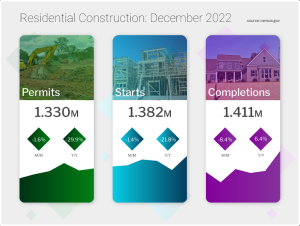
Housing Starts, which measure the start of construction on homes, fell 1.4% from November to December. Starts for single-family homes, which are the most important because they are in such high demand among buyers, were up 11.3% monthly but they are still 25% lower when compared to December 2021. Building Permits for single-family homes, which are indicative of future supply, also fell 6.5% for the month and 34.7% year over year.
What's the bottom line? While construction has slowed, December's data was better than expected. In addition, the low supply environment in new homes (and in existing homes as noted above) will continue to be supportive of prices. This is very different from the housing bubble, where demand was waning but the supply of new homes was significantly increasing.
Is the Uptick in Builder Confidence a Turning Point for Housing?
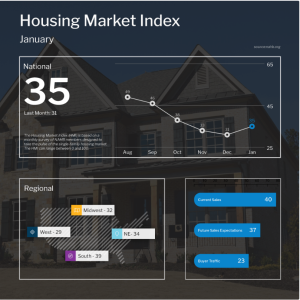
The National Association of Home Builders (NAHB) Housing Market Index, which is a near real-time read on builder confidence, rose four points to 35 in January. Among the components of the index, current sales conditions rose four points to 40, buyer traffic increased three points to 23, and sales expectations for the next six months moved two points higher to 37. Any reading above 50 on this index, which runs from 0 to 100, signals expansion while readings below 50 signal contraction.
What's the bottom line? The rise in confidence among home builders this month follows declines seen every month last year. NAHB Chairman Jerry Konter noted, "It appears the low point for builder sentiment in this cycle was registered in December, even as many builders continue to use a variety of incentives, including price reductions, to bolster sales." He added, "The rise in builder sentiment also means that cycle lows for permits and starts are likely near, and a rebound for home building could be underway later in 2023."
Wholesale Inflation Much Cooler Than Estimates
The Producer Price Index (PPI), which measures inflation on the wholesale level, fell by a greater than expected 0.5% in December. On a year-over-year basis, PPI decreased from a downwardly revised 7.3% to 6.2%. Core PPI, which strips out volatile food and energy prices, was in line with estimates with a 0.1% increase, though the previous report was revised lower. On an annual basis, Core PPI declined from 6.2% to 5.5%.
What's the bottom line? Overall, inflation continues to subside and the annual readings are moving lower in the right direction. In fact, the progress made on the producer side of inflation is notable. At its peak last March, PPI was at 11.7% year over year and is now almost half that amount at 6.2%.
Cooling inflation is a welcome sign for several reasons. Besides causing higher prices, inflation is the arch enemy of fixed investments like Mortgage Bonds because it erodes the buying power of a Bond’s fixed rate of return. If inflation is rising, investors demand a rate of return to combat the faster pace of erosion due to inflation, causing interest rates to rise as we saw through much of last year.
Jobless Claims Continue to Reflect Slower Pace of Hiring
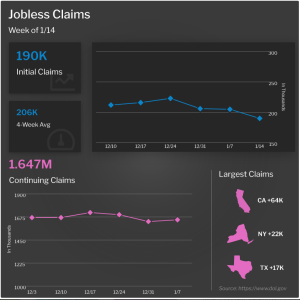
Initial Jobless Claims declined by 15,000 in the latest week, as the number of people filing for unemployment benefits for the first time fell to 190,000. Continuing Claims, which measure people who continue to receive benefits after their initial claim is filed, rose 17,000 to 1.647 million.
What's the bottom line? Continuing Claims have been trending higher since mid-September when they were at 1.346 million. This reflects a potential slowdown in the pace of hiring, suggesting it's becoming harder for many to find a job once they're let go.
Manufacturing and Retail Sales Data Point to Economic Slowdown
Recent reports offer more signals that the economy is slowing. In the manufacturing sector, there were negative readings (which signal contraction) reported for the New York and Philadelphia regions this month. The Empire State Index contracted sharply to -32.9, which was much worse than estimates, while the Philadelphia Fed Index remained in contraction territory for the fifth straight month.
Meanwhile, Retail Sales were also down 1.1% in December, which was a bigger decline than economists had forecasted, showing a disappointing end to the holiday shopping season.
Family Hack of the Week
Get that glass of milk ready! These Classic Peanut Butter Cookies courtesy of our friends at Allrecipes are a perfect way to mark National Peanut Butter Day on Tuesday, January 24.
In a large bowl, beat 1 cup unsalted butter, 1 cup crunchy peanut butter, 1 cup white sugar and 1 cup packed brown sugar with an electric mixer until smooth. Beat in eggs one at a time.
In a medium bowl, sift 2 1/2 cups all-purpose flour, 1 1/2 teaspoons baking soda, 1 teaspoon baking powder and 1/2 teaspoon salt. Add to peanut butter mixture until just combined. Chill dough in refrigerator for 1 hour.
Preheat oven to 375 degrees Fahrenheit. Roll dough into 1-inch balls and place 2 inches apart on an ungreased baking sheet. Flatten each ball with a fork, making a crisscross pattern.
Bake until edges are golden, approximately 10 minutes. Cool on the baking sheet for 5 minutes, then place on a wire rack to cool completely.
What to Look for This Week
Thursday brings a full slate of economic news, including December's New Home Sales and Durable Goods, the first reading on fourth quarter 2022 GDP, and the latest Jobless Claims.
On Friday, look for December's Pending Home Sales along with the Fed's favored inflation measure, Personal Consumption Expenditures.
Technical Picture
Mortgage Bonds ended last week trading in the middle of a range comprised of the 101.671 Fibonacci ceiling and a floor at the 25-day Moving Average. The 10-year broke above the ceiling at the 3.431% Fibonacci level. There is a lot of room for yields to worsen before reaching the next ceiling at the 25-day Moving Average.
Source: https://mbshighway.com

